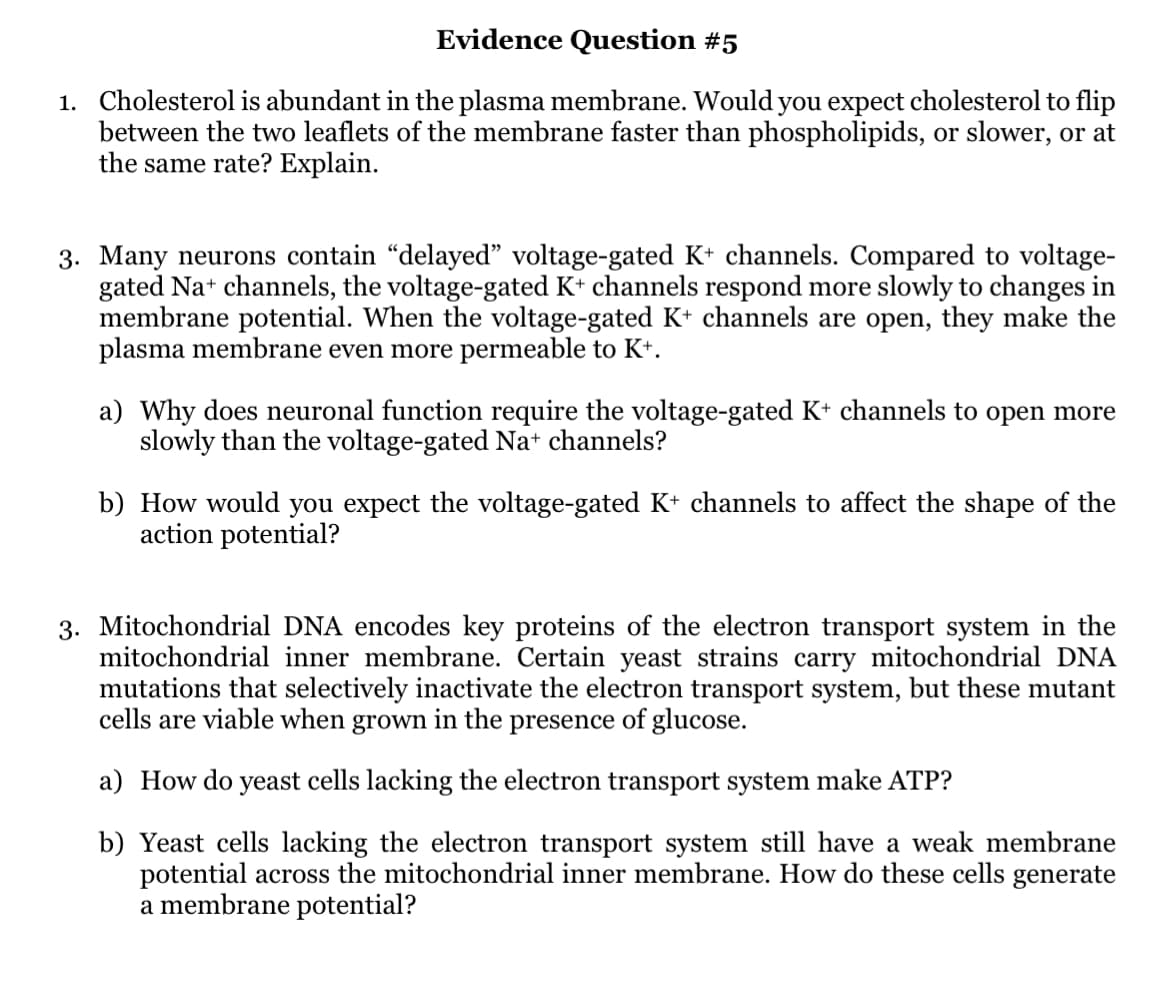Evidence Question #5 1. Cholesterol is abundant in the plasma membrane. Would you expect cholesterol to flip between the two leaflets of the membrane faster than phospholipids, or slower, or at the same rate? Explain. 3. Many neurons contain "delayed" voltage-gated K+ channels. Compared to voltage- gated Na+ channels, the voltage-gated K+ channels respond more slowly to changes in membrane potential. When the voltage-gated K+ channels are open, they make the plasma membrane even more permeable to K+. a) Why does neuronal function require the voltage-gated K+ channels to open more slowly than the voltage-gated Na+ channels? b) How would you expect the voltage-gated K+ channels to affect the shape of the action potential? 3. Mitochondrial DNA encodes key proteins of the electron transport system in the mitochondrial inner membrane. Certain yeast strains carry mitochondrial DNA mutations that selectively inactivate the electron transport system, but these mutant cells are viable when grown in the presence of glucose. a) How do yeast cells lacking the electron transport system make ATP? b) Yeast cells lacking the electron transport system still have a weak membrane potential across the mitochondrial inner membrane. How do these cells generate a membrane potential?
Evidence Question #5 1. Cholesterol is abundant in the plasma membrane. Would you expect cholesterol to flip between the two leaflets of the membrane faster than phospholipids, or slower, or at the same rate? Explain. 3. Many neurons contain "delayed" voltage-gated K+ channels. Compared to voltage- gated Na+ channels, the voltage-gated K+ channels respond more slowly to changes in membrane potential. When the voltage-gated K+ channels are open, they make the plasma membrane even more permeable to K+. a) Why does neuronal function require the voltage-gated K+ channels to open more slowly than the voltage-gated Na+ channels? b) How would you expect the voltage-gated K+ channels to affect the shape of the action potential? 3. Mitochondrial DNA encodes key proteins of the electron transport system in the mitochondrial inner membrane. Certain yeast strains carry mitochondrial DNA mutations that selectively inactivate the electron transport system, but these mutant cells are viable when grown in the presence of glucose. a) How do yeast cells lacking the electron transport system make ATP? b) Yeast cells lacking the electron transport system still have a weak membrane potential across the mitochondrial inner membrane. How do these cells generate a membrane potential?
Biochemistry
6th Edition
ISBN:9781305577206
Author:Reginald H. Garrett, Charles M. Grisham
Publisher:Reginald H. Garrett, Charles M. Grisham
Chapter32: The Reception And Transmission Of Extracellular Information
Section: Chapter Questions
Problem 20P
Related questions
Question
2A

Transcribed Image Text:Evidence Question #5
1. Cholesterol is abundant in the plasma membrane. Would you expect cholesterol to flip
between the two leaflets of the membrane faster than phospholipids, or slower, or at
the same rate? Explain.
3. Many neurons contain "delayed" voltage-gated K+ channels. Compared to voltage-
gated Na+ channels, the voltage-gated K+ channels respond more slowly to changes in
membrane potential. When the voltage-gated K+ channels are open, they make the
plasma membrane even more permeable to K+.
a) Why does neuronal function require the voltage-gated K+ channels to open more
slowly than the voltage-gated Na+ channels?
b) How would you expect the voltage-gated K+ channels to affect the shape of the
action potential?
3. Mitochondrial DNA encodes key proteins of the electron transport system in the
mitochondrial inner membrane. Certain yeast strains carry mitochondrial DNA
mutations that selectively inactivate the electron transport system, but these mutant
cells are viable when grown in the presence of glucose.
a) How do yeast cells lacking the electron transport system make ATP?
b) Yeast cells lacking the electron transport system still have a weak membrane
potential across the mitochondrial inner membrane. How do these cells generate
a membrane potential?
Expert Solution
This question has been solved!
Explore an expertly crafted, step-by-step solution for a thorough understanding of key concepts.
This is a popular solution!
Trending now
This is a popular solution!
Step by step
Solved in 5 steps

Knowledge Booster
Learn more about
Need a deep-dive on the concept behind this application? Look no further. Learn more about this topic, biology and related others by exploring similar questions and additional content below.Recommended textbooks for you

Biochemistry
Biochemistry
ISBN:
9781305577206
Author:
Reginald H. Garrett, Charles M. Grisham
Publisher:
Cengage Learning

Biochemistry
Biochemistry
ISBN:
9781305577206
Author:
Reginald H. Garrett, Charles M. Grisham
Publisher:
Cengage Learning